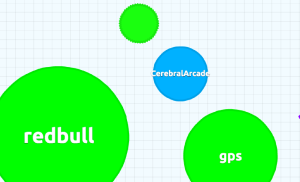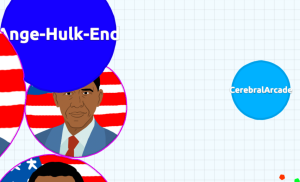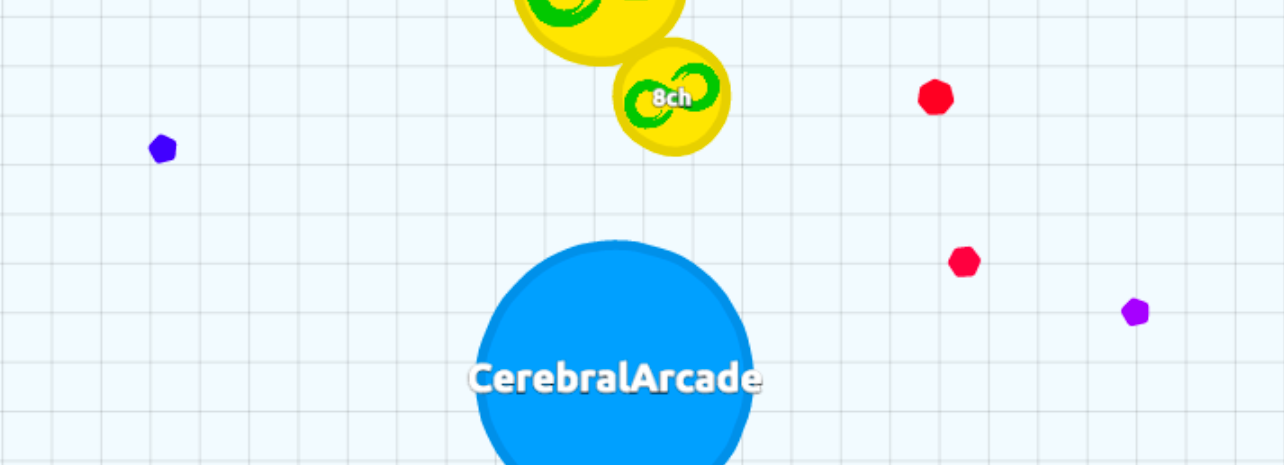Agario (2015) is one of those beautifully simple games that enables many interesting forms of emergent play with few mechanics. You are a blob who can eat anything smaller than you. When you do, you grow and get a little slower. You can perform 2 moves: one launches half of your mass forward for a move that can be used offensively to attack a smaller blob or defensively to abandon half your mass in an effort to survive being cornered. Your other move launches a small piece of your mass forward, which is sometimes used for baiting other players, but more often used to “feed” other blobs.
So basically, Agario is a game about consumption: both the aggressive, taking kind and the supportive, giving kind.
The game harkens back to an age of simple but addictive arcade games, approachable to new players but difficult to master, and wildly fun to play with friends. Agario is interruptible for quick sessions, but engaging enough to capture you for hours. It’s the first game in months to motivate me to call friends over for a LAN-party: cries of anguish, betrayal, and triumph are felt so much more viscerally in person than over voice chat. Consumption is the core experience of the game—indeed, the power fantasy underlying the game’s appeal—and I find it more satisfying than I’d like to admit. Moreover, I love the dynamics that have emerged around giving and sacrifice as communication.
 The surface goals of Agario are to dominate all of the other blobs, to consume them all until you are the biggest. Despite such an aggressive and cynical goal, in practice, reaching a huge mass is most easily achievable by teaming up with at least one other blob, allowing yourselves to split and feed each other while you attack outsiders. With no in-game chat or communication tools, a player might call for an alliance by offering up their own mass for feeding. This rudimentary act of giving is understood to be one of generosity, and many players will leave weaker players alone if they make such an offering. Others won’t. So it goes.
The surface goals of Agario are to dominate all of the other blobs, to consume them all until you are the biggest. Despite such an aggressive and cynical goal, in practice, reaching a huge mass is most easily achievable by teaming up with at least one other blob, allowing yourselves to split and feed each other while you attack outsiders. With no in-game chat or communication tools, a player might call for an alliance by offering up their own mass for feeding. This rudimentary act of giving is understood to be one of generosity, and many players will leave weaker players alone if they make such an offering. Others won’t. So it goes.
The mechanics are abstract enough that many symbolic interpretations are easy to read into them. Players are quick to name their blobs for something they associate with dominance or superiority. Brand loyalism is rampant, with consumer fandom battles playing out on the Agario field via blobs named “Apple” and “PC” vying to consume all others and grow the largest. Other players choose names that signal growth or consumptive largeness—“Kanye’s Ego” is one of my favorites—while still others name their blobs after celestial bodies. Names can be used to signal alliance or opposition: you might see “Sun” and “Moon” working together while “Coke” and “Pepsi” battle it out. Some names automatically add an image to your blob, and one of the few disappointing aspects of the game is the limited sets of skins, namely, the skins the developers found it most prudent to add first.
Skins are an acknowledgement that the developers recognize the rhetoric of their game and have included some art to make it more concrete. For example, changing your name to “Nasa” might change your background to the Nasa logo. The very fact that this logo was given the extra development time to create art for it means that representing Nasa in the game is something the developers thought players would want. But despite this opportunity for fun character customization, the list of skins feels like it was created by trolls. For example the websites the developers felt warranted skins are Reddit, 2chan, 4chan, and 8chan (yes, all 3), Facepunch, Tumblr, and 9gag, all sites vehemently attacked or defended by a certain class of Troll Gamer, and the omission of other sites feels remarkably myopic. The list of concepts that received art development resources betrays either very narrowly-focused developers or an expectation for their players to be Gamer caricatures. But the developers take suggestions for future skins, so hopefully we can expect better in the future, and all skins and names are toggleable.
 Still, Agario is overall a very solid experience—a few server lag spikes aside. Play seems to have 3 distinct phases with different strategies depending on your size, and all of them feel well-balanced. It would be easy in these games for the huge to dominate everyone, but the tuning of speed to size and the risk inherent in splitting makes for a well-tuned experience suited to both cooperation and competition. And everything can change in an instant.
Still, Agario is overall a very solid experience—a few server lag spikes aside. Play seems to have 3 distinct phases with different strategies depending on your size, and all of them feel well-balanced. It would be easy in these games for the huge to dominate everyone, but the tuning of speed to size and the risk inherent in splitting makes for a well-tuned experience suited to both cooperation and competition. And everything can change in an instant.
The top level of play is balanced by green spiky terrain blobs (called viruses) that offer protective hiding places for smaller blobs, and if eaten will cause large blobs to temporarily split into several smaller, more vulnerable pieces. Feeding these can split and “shoot” them at other huge players. “Obama” may have worked together with “Hilary Clinton” to reach a huge mass, but if Obama makes a false step and eats a virus, Hilary will be quick to consume his pieces. After all, if she doesn’t, someone else will, maybe “Donald Trump”.
Or maybe Obama will purposefully eat a virus to allow Hilary to consume him. That way, Hilary can grow large enough to eat Donald Trump. Maybe she’ll reward Obama for his troubles by feeding him part of her mass.
Or maybe she’ll just eat him and move on.


